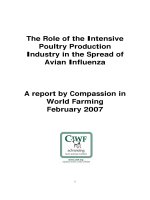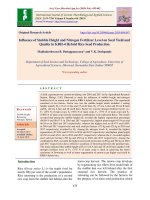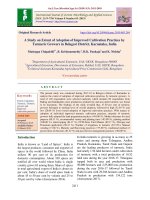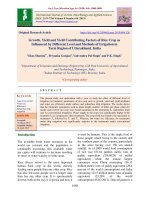Extent of adoption level of improved maize production technology in Saharsa district of Bihar, India
Bạn đang xem bản rút gọn của tài liệu. Xem và tải ngay bản đầy đủ của tài liệu tại đây (119.21 KB, 5 trang )
Int.J.Curr.Microbiol.App.Sci (2018) 7(7): 2373-2377
International Journal of Current Microbiology and Applied Sciences
ISSN: 2319-7706 Volume 7 Number 07 (2018)
Journal homepage:
Original Research Article
/>
Extent of Adoption level of Improved Maize Production
Technology in Saharsa District of Bihar, India
Sarvesh Kumar* and O.P. Mishra
Department of Extension Education, Institute of Agricultural Science,
Banaras Hindu University, Varanasi-221005 (U.P.),
*Corresponding author
ABSTRACT
Keywords
Adoption level,
Improved Maize
Production
Article Info
Accepted:
17 June 2018
Available Online:
10 July 2018
Adoption is decision to make full use of new ideas as the best course of action available.
The term adoption, in this study is used to denote use of improved maize cultivation
practices by farmers. Maize production has shown a tremendous increase in the country.
The growth rate of production of maize since last five years is higher in India than that of
maize in USA and China. The productivity of maize with more than 4 t/ha in Rabi season
is catching up with global average productivity of maize. India is now major maize
producer after USA, China, Brazil and Argentina. This is largely due to adoption of
improved technologies by Indian farmers.
Introduction
There are tremendous opportunities to further
enhance maize production in the country.
India will need 65 million tonnes of maize by
2050. This increase in production should
preferably come from increase in productivity
rather than area. The most critical factors to
realize this would be enhancement and
diversification of germplasm using modern
tools and techniques, development of diverse
and productive inbreeds and fine-tuning of
resource conservation techniques and to bring
down cost of cultivation by enhancing
resource use efficiency by maize. India has
strategic and geographical advantage over
other countries towards supply of maize to
international market. This include round-theyear production of maize in our country, low
freight charges,
well-established
seed
production and marketing network and
availability of sea-port. The demand of
special type maize like sweet corn, pop corn,
oil corn and waxy corn is in increasing
trend. Now, more rigorous efforts are being
made to fulfil this demand.
Materials and Methods
The state Bihar was selected purposively
because it is one of the prominent Rabi maize
growing states in India. Winter maize is a
natural gift provided to Bihar with very high
yield potential i.e. 8.0 to 9.0 ton per ha.
2373
Int.J.Curr.Microbiol.App.Sci (2018) 7(7): 2373-2377
Saharsa district of Bihar was selected
purposively because it has highest area and
production of the maize as compared to other
districts of the state. The other resourceful
institutions like, KVK & Agriculture College
are also located in this district. Saharsha
district comprises 10 blocks. Out of 10 blocks,
two blocks i.e. Kahra and Nauhatta were
selected through randomly sampling. A
complete list of all the major maize growing
villages was prepared in consultation with the
personnel of revenue and agriculture
department from the identified blocks. From
the list so prepared, three villages from each
identified block were selected on the basis of
random selection technique. Thus, in all six
villages were selected for the present
investigation. All maize growers were taken as
the population of the study. From the
population a sample of total 220 were selected
through proportionate random sampling
technique. Numbers of respondents were
found to be in proportion to the total
population of the maize growers in the
concerned village. Total 5% of sample size is
selected from entire maize grower population
of concerned village.
Measurement of adoption level
Extent of
technology
adoption
of
comprising maize breeder, maize agronomist,
agronomy students of IAS, BHU were
contacted in person with a request to indicate
the degree of ease of adoption of selected
practice of the technology by the farmers.
The scoring procedure followed for
quantifying responses was:
Procedure adopted in the quantification of
extent of adoption
Proportion for each of ten practices
(actual/recommended) were calculated and
multiplied by the corresponding weight. Then
these values of all ten items were summed and
divided by 34, total number of weights. The
resulting value was multiplied by 100 to
indicate the percentage of the extent of
adoption of the package of practice for HYV
of maize.
Proportion for each of ten practices
(actual/recommended) were calculated and
multiplied by corresponding weight. Then,
these values of all eight items were summed
and divided by 34 the total number of weights.
The resulting value was multiplied by 100 to
indicate the percentage of the extent of
adoption of the package of practice for HYV
of maize.
agricultural
Adoption index of H .Y .V Maize
The extent of adoption for the recommended
package of practices to cultivate high yielding
varieties of maize was measured by means of
adoption index, developed on the line of
adoption intensity index used by Choubey
(1972). As purpose was to quantify the extent
of adoption of packaging practices for the
cultivation of high yielding varieties of maize,
this procedure was followed. Ten practices of
technology were selected to study the extent
of adoption.
To fix weightage based on the intrinsic
difficulty of adoption of practices, 50 judges
Total Score
*100
Total weightage
Results and Discussion
Extent of adoption of recommended maize
cultivation practices by the farmers
The distribution of beneficiaries in different
categories was made by working out mean and
SD. The mean adoption score obtained was
(77.1) and standard deviation (3.61) were
computed for the purpose of classifying the
extent of adoption level in to three categories
namely low level, medium level and high
2374
Int.J.Curr.Microbiol.App.Sci (2018) 7(7): 2373-2377
level of adoption, in this way groups are as
follows:
Farmers who obtained adoption score below
73.00 were categorized as low adopters.
Farmers who obtained adoption score from
73.00 to 81.00 were categorized as medium
adopters. Farmers who obtained adoption
score above 81.00 were categorized as high
adopters.
As it is apparent from data in Table 1 fig that
maize growers of about 69.5 per cent were
found to be in medium adoption, while 19.5
per cent farmers were in low adoption level
and only 11.00 per cent of farmers were in
high adoption level respectively.
These findings confirm the findings of Dhruw
(2008), who revealed that soybean growers
had medium adoption level followed by high
and low adoption level about improved
cultivation practices of soybean.
Furthermore the extent of adoption of
recommended maize cultivation practices was
also analyzed separately. The relative adoption
of all ten practices of recommended maize
cultivation was highlighted by ranking their
extent of adoption on the basis of adoption
index. The adoption index were obtained by
multiplying total obtained score of
respondents by hundred and divided by total
weightage under each practice.
The data presented in the Table 2 indicates
that had highest (81.11AI) adoption about soil
and field preparation and hence this practice
was ranked first. The second highest
percentage of farmers had adoption level of
(79.77AI) about High yielding varieties
(HYVs) followed by Seed rate, spacing and
depth of showing (76.11AI) and Time of
sowing (75.64 AI) which were ranked third
and fourth respectively. The extent of
adoption of recommended maize cultivation
practice like Irrigation, weed management ,
fertilizer application, and Harvesting were
moderately known by farmers as they were
having 73.18,70.83,70.30,68.85 AI which
were ranked fifth ,sixth, seventh, and eighth
respectively. Lowest adoption was found in
plant protection measures (67.09 AI) and seed
treatment (66.51AI) hence last ninth and tenth
ranks were assigned to them, respectively.
Table.1 Frequency distribution of farmers under different adoption levels of recommended
maize cultivation practices
S.No.
Adoption level
Respondents (N=220)
Frequency
Percentage
1
Low (score below 73.00)
043
19.5
2
Medium (score from 73 to 81)
153
69.5
3
High (score above 81)
024
11.0
Total
220
100.0
Mean = 77.1
2375
SD=3.61
Int.J.Curr.Microbiol.App.Sci (2018) 7(7): 2373-2377
Table.2 Practice wise adoption Index of farmers about recommended maize cultivation practices
S.N.
Package of practices
Adoption Index
Rank
Soil and land preparation
81.11
I
1
High yielding varities (HYVs)
79.77
II
2
Time of showing
75.64
IV
3
Seed treatment
66.51
X
4
Seed
rate,
Spacing
76.11
III
5
Fertilizer application
70.30
VII
6
Weed management
70.83
VI
7
No of irrigation
73.18
V
8
Plant protection measures
67.09
IX
9
68.85
VIII
10 Harvesting
Measurement of Adoption Behaviour
p
1
Practices
Use of HYV Maize variety
(Soil and Field preparation)
Weight age
2
2(a)
Seed rate
2
actual seed rate used / acre
*Weight
recommended seed rate / acre
2(b)
Seed treatment
3
Actual dose applied
*Weight
Recommended dose
2(c)
Spacing (P-P)
3
Actual spacing/Recommended spacing *Weight
2(d)
Spacing(R-R)
3
Actual spacing/Recommended spacing *Weight
3
Intercultural Operation
2
4
Application of nitrogen
2
Actual No of Io/Recommended No Io*Weight
Quantity ofN applied / acre
*Weight
Quantity of N recommended / acre
5
Application of
phosphorous
2
Quantity of P2 05 applied / acre
*Weight
Quantity of P2 05 recommended / acre
6
Application of potassium
2
Quantity of K 2 0 applied / acre
*Weight
Quantity of K 2 0 recommended / acre
7
Application of
micronutrients
3
Actual dose applied
*Weight
Recommended dose
8
Irrigation
2
Actual No of irrigation/Recommended No of
irrigation*Weight
9(a)
Herbicides
3
Actual dose applied
* Weight
Recommended dose
9(b)
Insecticides/pesticides
3
Actual dose applied
*Weight
Recommended dose
10
Harvesting
2
Actual yield/Recommended yield*Weight
2376
Procedure
actual area
*Weight
potential area
Int.J.Curr.Microbiol.App.Sci (2018) 7(7): 2373-2377
The scoring procedure followed for quantifying responses was:
Sl. No.
1
2
3
4
5
Particular
Very difficult
Difficult
Neither difficult nor easy
Easy
Very easy
Score
5
4
3
2
1
The mean score from judged responses were rounded to the nearest whole number for each practice and assigned
weightage for the respective practice.
It was found that 153 (69.50%) of total maize
growers were found to be from medium
adoption level group, followed by 43
(19.50%) respondents were reported from the
group of low adoption level and 24 (11.00%)
respondents were in the high adoption level.
The findings indicate that, (81.11AI) adoption
about soil and field preparation and hence this
practice was ranked first. Lowest adoption
was found in plant protection measures (67.09
AI) and seed treatment (66.51AI) hence last
ninth and tenth ranks were assigned to them,
respectively. It was observed that there was a
significant difference among all farmers with
regard to adoption of improved maize
cultivation technology.
References
Chaube, C.L. 1972. A study of differential
adoption of high yielding wheat
How to cite this article:
varieties technology as related to
influence by selected demographic,
socio-phychological and political
variables in Sehore district, Madhya
Pradesh. Ph.D. Thesis, Division of
Agril Extension, IARI, New Delhi.
Dhruw, K.S. 2008. A study on adoption of
recommended
maize
production
technology among the farmers of
Kanker district of Chhattisgarh state.
M.Sc. (Ag.) Thesis, Indira Gandhi
Krishi Vishwavidyalaya, Raipur
Source:
/>english/bihar/bihar_census_2011.html
retrieved on 12 January 2016 at 11.23
pm
Source: Data Book, ICAR, 2016 retrieved
on 2 December 2015 at 11 am.
www.iimr.nic.in retrieved on 04 December
2015 at 7 pm.
Sarvesh Kumar and Mishra, O.P. 2018. Extent of Adoption level of Improved Maize
Production Technology in Saharsa District of Bihar. Int.J.Curr.Microbiol.App.Sci. 7(07): 23732377. doi: />
2377









